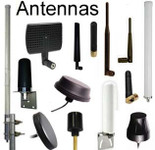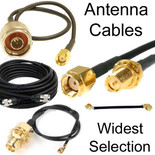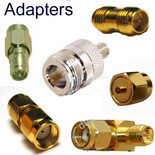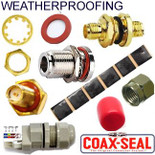Antennas, Antenna Cables, Wireless Products: Technical Articles
U.FL Cables Coax Types Compared: 1.13mm, 1.32mm, 1.37mm, RG174, RG178
Table of Contents
U.FL Cable Coax Comparison
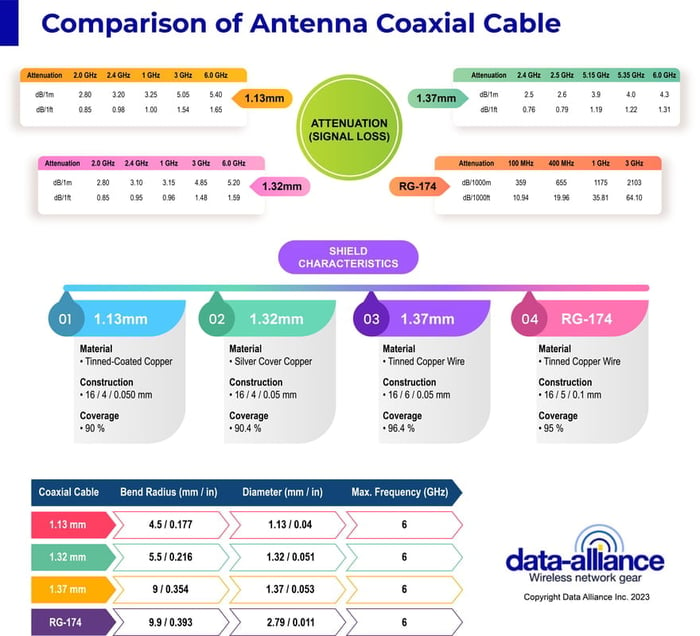
1.13mm coaxial cable is the most commonly-used coax for U.FL cables - especially short cables. 1.13 is the only coax that can be used with MHF4 cables.
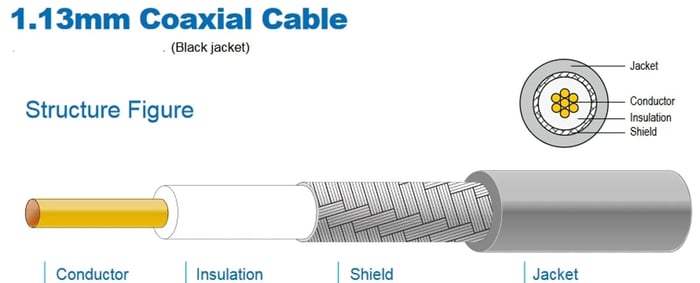
When connecting U.FL connector to a jack on a mini-PCI card or board, sometimes the tight space requires the use of 1.13mm cable, because it is very thin and flexible: It is not always necessary to use 1.13mm cable, but on occasion it is necessary to use 1.13mm cable, to prevent the U.FL connector from popping off the U.FL jack (sometimes in tight spaces, RG174 and RG178 cause the U.FL connector to pop off).
1.13mm cable has a 50 Ohm resistance (+/- 3Ohm) and is a single shielded coaxial cable with a FEP jacket.
Operating temperature range of 1.13mm coax: -55°C - +180 °C
Differences with RG174 include:
- Overall smaller diameter of 1.13mm (0.04 inches), an AWG of 32.
- A smaller diameter (0.26mm – 0.01 inches) silver plated annealed copper core and non-polymer dielectric.
- Low loss 1.13 coax variants also have an insulating binder made from copper polyester tape which enhances shielding.
- 1.13 coax achieves a lower conductor resistance (482Ohm/km) than RG178 and similar insulation resistance (3000 Ohm/km).
- Its VSWR is 1.3 between 0 and 6 GHz up to a maximum of 1.45 between 6 and 8GHz. Optimal frequency is 6GHz.
1.32mm coaxial cable has 50 Ohm resistance (+/- 3Ohm). It is single shielded with a silver covered copper braid and has an FEP jacket. Key differences with RG174 include: Lower diameter – the dielectric diameter is 0.70 mm (0.028 inches). The AWG of the cable is 32 A conductor diameter 0.22mm. The core is silver plated solid copper. Coverage of the braided shielding may be lower at 90%. A double shielded variant of 1.32mm coaxial cable has two layers of silver coated copper braid with the additional layer having coverage of 78%. Conductor resistance is slightly higher at 850Ohm/km and insulation resistance is lower than that of RG178 at 1000Ohm/km. VSWR is equivalent at 1.3 between 0 and 6 GHz. Optimal frequency is 6 GHz.
1.37mm coax: Best Choice for Low Loss: 1.37mm mini coaxial cable has similar signal loss as RG174 and RG178, but is thinner and more flexible: It has same size conductor as RG178 cable, but smaller overall diameter. It's flexibility helps the U.FL cable connectors stay attached, and makes it more suitable than RG174 or RG178 for the tight space of a small case or enclosure. See attenuation table and specs of 1.37mm mini coax cable.
RG174 (also known as ‘mini-coax’ or ‘micro-coax’)
RG174 cable has a 50 Ohm resistance (+/- 2Ohm) and single shielding with tinned copper braid but differs in the following ways:
- Its non-polar polymer dielectric is typically made from polyethylene (PE) and has almost double the amount of insulation present by diameter.
- Its central conductor can be stranded with up to 7 strands of copper clad steel and is of greater diameter (0.48mm vs 0.31mm for RG178)
- Depending on the manufacturer, the jacket is made from PVC.
- Overall diameter is greater than RG178 at 2.79mm (0.11 inches) and AWG is lower at 26.
- RG174 has a much lower conductor resistance (142Ohm/km) and higher insulation resistance (1000Ohm/km). Optimum frequency is 2.4Hz.
| ATTENUATION dB/ft. | |||||
|---|---|---|---|---|---|
| Freq. (MHZ) | RG178 | RG174 | 1.13 | 1.32 (SGL Shield) | 1.32 (DBL Shield) |
| 900 | 0.408 | 0.300 | 0.71 | 0.71 | 0.71 |
| 2000 | 0.630 | 0.86 | 1.00 | 0.85 | |
| 2500 | 0.784 | 0.740 | 0.98 | 0.96 | |
| 3000 | 0.820 | 1.06 | 1.21 | 1.21 | |
| 5000 | 1.38 | 1.54 | 1.55 | 1.48 | |
| 6000 | 1.50 | 1.65 | 1.70 | 1.59 | |
See list of all of our articles about U.FL cables and connectors.
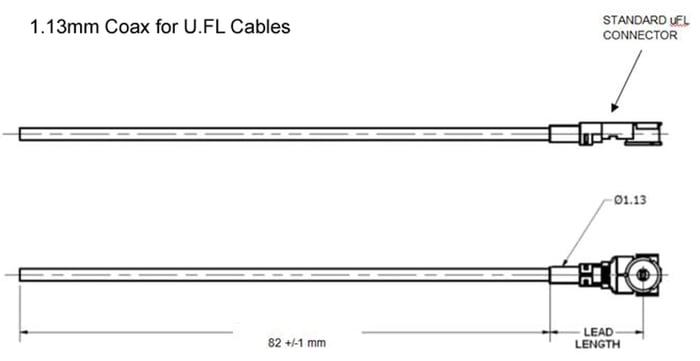
RG 178 Applications
RG 178 is a thin cable with good thermal resistance (operating temperature range from -55 to 200 degrees Celsius or -67 to 392 degrees Fahrenheit). It is typically used for high frequency transmissions. This coax cable has a variety of commercial uses including:
- Testing and measurement
- Internal cabling
- Television and CCTV
- Telecommunications and broadband
- Wireless communication infrastructure
Structure and Material Composition of RG178 Coaxial Cable
RG 178 has an American Width Gauge (AWG) of 30 and an overall diameter of 1.83millimeters (0.071 inches). The bend radius of this cable is usually between 7.5mm (0.29 inches) and 9.0mm (0.35 inches). RG 178 cable’s structure is typical of coaxial cable comprising:
- A central conductor made of silver coated, copper clad steel with a diameter of 0.3 millimeters (0.01 inches).
- Insulation material to surround the conducting core of 0.86 millimeters (0.03 inches), known as a dielectric, made from Polytetrafluoroethylene (PTFE).
- A single metallic shielding layer – made from woven or braided silver coated copper. The shield coverage is typically 95% and influences the transmitting performance of the cable.
- An external plastic jacket made from Fluorinated ethylene propylene (FEP) which may be opaque or transparent.
Electrical Characteristics of RG178 Coaxial Cable
RG178 has a relatively tightly matched impedance of 50 Ohm with a range of (+/- 2 Ohm) and VSWR of up to 1.3 between 0 and 6 GHz. The conductor resistance of this cable is typically around 800 Ohm/km and the dielectric resistance is 3000 Ohm/km. Optimum frequency range for this cable is between 2.5 GHz and 3 GHz.
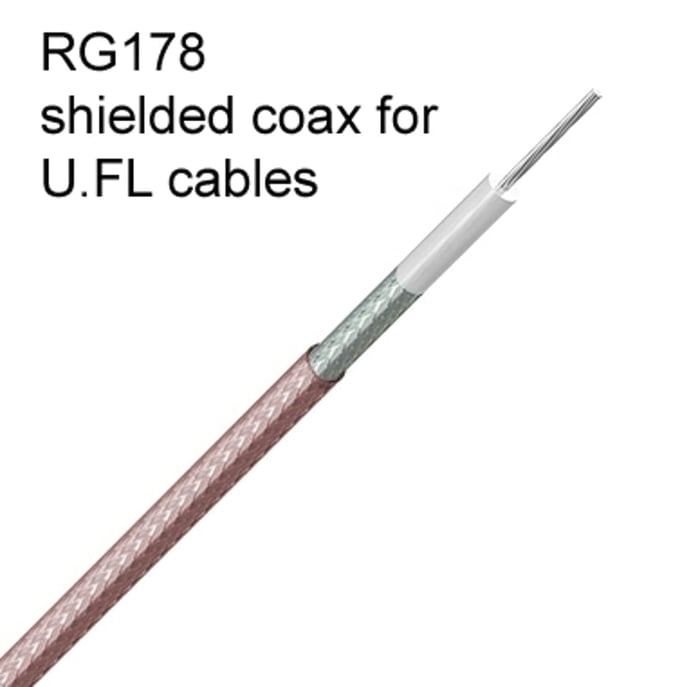
RG in RG178 stands for Radio Guide and is a designation given to a range of coaxial cables which were originally developed during the World War II era for military purposes. The RG number specifies the gauge, or thickness of the cable. Higher RG numbers are typically associated with a thinner central conductor in the coax cable. Overall greater diameters are due mainly to the insulating layers of the cable and provide lower attenuation of signal over longer lengths of cable.
It is important to note that the electrical and radio frequency characteristics of a specific coaxial cable may vary in performance from manufacturer to manufacturer. Exact performance and suitability for applications can be discerned from individual manufacturer specifications. Most RG 178 coax will also conform to the standards of MIL-C-17F or some other US military connector specification.
Conclusion: U.FL Coax Cable Comparison
The comparison shows that 1.13mm, 1.32mm, and 1.37mm mini coax cables are preferred for compact U.FL connections where flexibility and space are critical, while RG174 and RG178 serve broader commercial and test applications requiring durability and lower signal loss over distance.
- 1.13mm coax is the thinnest and most flexible option, ideal for tight spaces and MHF4 connectors, though it has higher attenuation.
- 1.32mm and 1.37mm offer a balance between flexibility and performance, with 1.37mm being the best low-loss alternative for compact designs.
- RG174 provides the lowest signal loss but is thicker and less flexible, suited for longer runs.
- RG178 withstands high temperatures and is reliable for high-frequency transmissions and internal cabling.
Overall, the choice of coax depends on the application’s trade-off between size, flexibility, and signal performance, with 1.13mm favored for confined installations and RG174 or RG178 for more robust, extended connections.
FAQs
What is the most commonly used coaxial cable for U.FL cables?
The 1.13mm coaxial cable is the most commonly used for U.FL connections, especially for short cables. It’s the only coax type compatible with MHF4 connectors, and its thin, flexible design makes it ideal for tight spaces on mini-PCI cards or circuit boards.
Why is 1.13mm coax sometimes required for U.FL connections?
Due to its thin and highly flexible construction, 1.13mm coax prevents U.FL connectors from popping off in tight installations where thicker cables like RG174 or RG178 can create strain on the connector or jack.
What are the main differences between 1.13mm and RG174 coax cables?
Compared to RG174, 1.13mm coax has a much smaller diameter (1.13mm vs. 2.79mm), higher flexibility, and lighter weight. However, RG174 offers lower signal loss and better insulation resistance, making it preferable for longer cable runs where space is less limited.
Which coax cable offers the best low-loss performance for compact installations?
The 1.37mm mini coax is considered the best low-loss option for U.FL cables. It combines similar signal performance to RG174 and RG178 with a thinner, more flexible form factor—ideal for small enclosures or devices with limited internal space.
What are the impedance and operating temperatures of these mini coax cables?
All U.FL-compatible mini coax types (1.13mm, 1.32mm, 1.37mm) have a 50 Ohm impedance (±3 Ohm). The 1.13mm coax operates from -55°C to +180°C, making it suitable for demanding environmental and industrial applications.
What are typical applications for RG178 coaxial cable?
RG178 is used in high-frequency and high-temperature applications, including testing and measurement, internal cabling, CCTV, telecommunications, and wireless infrastructure. It features a silver-coated conductor and PTFE dielectric for stability and reliability up to 200°C.
How do attenuation and performance compare among these coax cables?
Thicker cables like RG174 have lower attenuation (less signal loss), while thinner cables like 1.13mm have higher attenuation but offer greater flexibility. 1.32mm and 1.37mm cables strike a balance, maintaining strong performance at frequencies up to 6 GHz.

